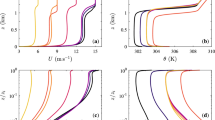Abstract
A three-dimensional nonhydrostatic model is used to calculate the complex wind field in a coastal and a hilly region. These results are used to test the applicability of a mass-consistent wind model for different numbers of input wind data. While for the coastal area the mass consistent model calculates reasonable results even for a small number of input wind data, this number increases significantly in complex terrain.
Similar content being viewed by others
References
Dickerson, M. H.: 1978, ‘MASCON — A Mass Consistent Atmospheric Flux Model for Regions with Complex Terrain’, J. Appl. Meteorol. 17, 241–253.
Feller, W.: 1995, ‘Ein regionales Ausbreitungsmodell für inerte Luftfremdstoffe basierend auf typischen Windfeldern’, Report CH-010, Paul-Scherer Institut, Villingen, Schweiz.
Goodin, W. R., McRae, G. J. and Seinfeld, J. H.: 1979, ‘A Comparison of Interpolation Methods for Sparse Data: Applications to Wind and Concentration Fields’, J. Appl. Meteorol. 18, 761–771.
Gross, G.: 1989, ‘Numerical Simulation of the Nocturnal Flow Systems in the Freiburg Area for Different Topographies’, Contr. Atmos. Phys. 62, 57–72.
Gross, G.: 1991, ‘Anwendungsmöglichkeiten mesoskaliger Simulationsmodelle dargestellt am Beispiel Darmstadt. Teil I: Windund Temperaturfelder’, Meteorol. Rdsch. 43, 97–112.
Gross, G.: 1992, ‘Results of Supercomputer Simulations of Meteorological Phenomena’. Fluid. Dyn. Res. 10, 483–498.
Ishikawa, H.: 1994, ‘Mass-Consistent Wind Model as a Meteorological Preprocessor for Tracer Transport Models’, J. Appl. Meteorol. 33, 733–743.
Massmeyer, K., Born, K., Erbshäuser, B., Hauk, C. and Flassak, Th.: 1990, ‘Regional Flow Fields in Northrhine Westfalia — A Case Study Comparing Flow Models of Different Complexity’, Presented at the 18th ITM on Air Pollut. Meteorol. and its Applications, Vancouver.
Moussiopoulos, N. and Flassak, Th.: 1986, ‘Two Vectorized Algorithms for the Effective Calculations of Mass-Consistent Flow Fields’, J. Appl. Meteorol. 25, 847–857.
Pielke, R. A.: 1984, Mesoscale Meteorological Modeling, Academic Press, 612 pp.
Schlünzen, K. H.: 1994, ‘Mesoscale Modeling in Complex Terrain — An Overview on the German Nonhydrostatic Models’, Contr. Atmos. Phys. 67, 243–253.
Sherman, C. A.: 1978, ‘A Mass-Consistent Model for Wind Fields Over Complex Terrain’, J. Appl. Meteorol. 17, 312–319.
Author information
Authors and Affiliations
Rights and permissions
About this article
Cite this article
Gross, G. On the applicability of numerical mass-consistent wind field models. Boundary-Layer Meteorol 77, 379–394 (1996). https://doi.org/10.1007/BF00123533
Accepted:
Issue Date:
DOI: https://doi.org/10.1007/BF00123533




